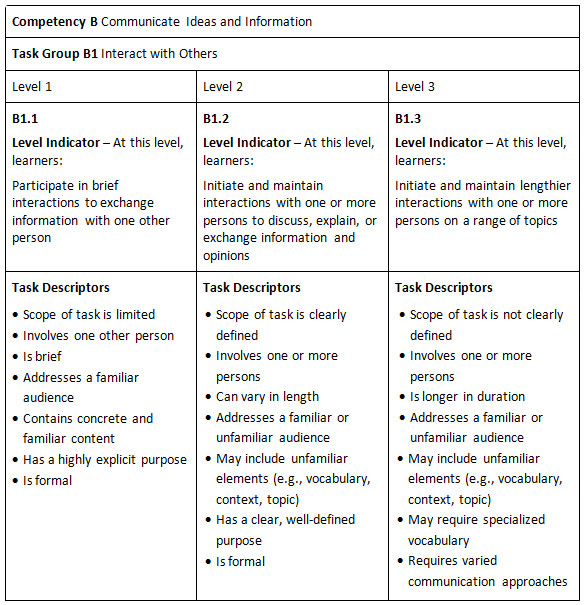Levels of Performance
Level Indicators
The Ontario Adult Literacy Curriculum Framework (OALCF) uses three performance levels with Level Indicator statements to describe the learners’ proficiency to carry out tasks within the Task Groups. These indicators provide an overview of the programming focus for that Task Group level. They also illustrate learner achievement in the Task Group, at the end of each level. The following is an example of a Level Indicator:
- Competency: C Understand and Use Numbers
- Task Group: C1 Manage Money
- Level Indicator: C1.2 At this level, learners “Make low-level inferences to calculate costs and expenses that may include rates such as taxes and discounts.”
The three levels of the OALCF use the same complexity factors as the first three levels of Canada’s Essential Skills (ES) (www.hrsdc.gc.ca/eng/jobs/les/definitions/index.shtml) and the three international adult literacy surveys, carried out in Canada by Statistics Canada (www.statcan.gc.ca):
- The International Adult Literacy Survey (IALS)
- The Adult Literacy and Life Skills Survey (ALLS)
- The Program for the International Assessment of Adult Competencies (PIAAC)
The OALCF uses two factors in interpreting a learner’s developing proficiency – Task Descriptors and Performance Descriptors. It is important that the description of both the task and the learner’s performance be considered together.
OALCF Task Descriptors
Task Descriptors help us to understand the features of the task that determine the task complexity. According to the OALCF, tasks are more complex when they
- are not well defined
- require more steps
- can be completed in more than one way (have no set procedure)
- contain unfamiliar elements (context, vocabulary)
- involve multiple or complex documents and texts
For example, in the following chart, we make comparisons between the Task Descriptors for the three levels of Task Group B1 “Interact with Others”:
OALCF Performance Descriptors
The Performance Descriptors illustrate how learners carry out tasks at the end of a level. According to the Curriculum Framework, learners who perform increasingly complex tasks can
- make inferences of task requirements
- apply background knowledge & experience to unfamiliar tasks
- manage tasks with unfamiliar elements
- identify a variety of ways to complete tasks
- find, integrate & analyze information
- experiment & problem-solve
A Note About Competencies and Levels
A learner’s ability to perform tasks can vary amongst the competencies. A learner may well be able to “Read longer texts to connect, evaluate, and integrate ideas and information” (A1.3 – Competency A: Find and Use Information, Task Group A1: Read Continuous Text, Level 3), but need help with understanding and using numbers to manage data (C4) at a Level 3 – “Find, integrate, and analyze data; identify trends in data.”
“The Ontario Adult Literacy Curriculum Framework (OALCF) supports the primary purpose of the LBS Program to help learners bridge the gaps in the literacy and numeracy abilities they need for goal achievement.” (OALCF Foundations of Transition-Oriented Programming, 2011)
For the most up-to-date information on the OALCF and to access the OALCF tools and resources, visit: www.tcu.gov.on.ca/eng/eopg/programs/lbs_oalcf_resources.html
Employment Ontario Information System – Case Management System (EOIS-CaMS)
EOIS-CaMS is a computer system developed to support EO service deliverers in the administration and management of their client cases. This includes Literacy and Basic Skills service providers’ learner case management. The data collected from EOIS-CaMS helps MTCU to analyze our efficiency and effectiveness as LBS service providers. Reports that can be printed from EOIS-CaMS at the provider level also provide valuable evaluation data for program managers. For more information about EOIS-CaMS and how to use it, go to the EOIS-CaMS section of the Employment Ontario Partners’ Gateway (EOPG) at www.tcu.gov.on.ca/eng/eopg/eotransformation/eois-cams.html. You can also view three webinars, produced by CLO, on program management through the Webinars link at www.communityliteracyofontario.ca/webinars.htm
Questions and Activities for Reflection
- Take a few minutes to scan through the Ontario Adult Literacy Curriculum Framework (www.tcu.gov.on.ca/eng/eopg/publications/OALCF_Curriculum_Framework_Oct_11.pdf) to better understand its features.
- In the Ontario Adult Literacy Curriculum Framework, at the end of the section for each level in a task group, you will find example tasks learners can do at the end of the level. Choose an example task from each of the competencies A, B, C and D, in whichever task group and level you wish, then do the task or think through it in your mind. Afterwards, review the Performance and Task Descriptors to see if and how they relate to the task.
- What situations in your learning environment could you use to measure the last two competencies?
- Competency E – Manage Learning
- Competency F – Engage with Others
Pages: 1 2




